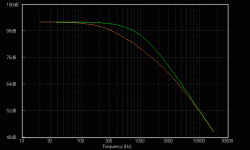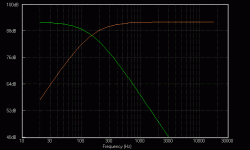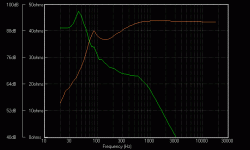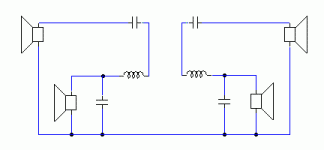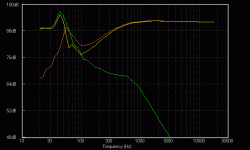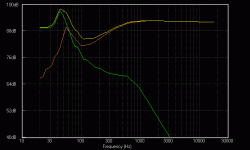in general ?
depends on whether its a tweeter or woofer, or mid
in other words, high pass or low pass
series inductor reacts as if twice as big, thus cuts lower
series caps on a tweeter reacts the opposite, and like it was smaller
and so on
simpler
low impedance results in smaller series inductor(low pass)
high impedance results in smaller series cap(high pass)
depends on whether its a tweeter or woofer, or mid
in other words, high pass or low pass
series inductor reacts as if twice as big, thus cuts lower
series caps on a tweeter reacts the opposite, and like it was smaller
and so on
simpler
low impedance results in smaller series inductor(low pass)
high impedance results in smaller series cap(high pass)
lol, i *almost* understood that 
im using one of these in a recent build,
DIAMOND 2 WAY STEREO PASSIVE SUBWOOFER CROSSOVER S @NEW | eBay
when i connected my (4) subwoofers, each pair was about 3.9 ohms.
i think they should have been 8 ohms / pair?
sounds good, just wondering whats actually xed over where ??
??
im using one of these in a recent build,
DIAMOND 2 WAY STEREO PASSIVE SUBWOOFER CROSSOVER S @NEW | eBay
when i connected my (4) subwoofers, each pair was about 3.9 ohms.
i think they should have been 8 ohms / pair?
sounds good, just wondering whats actually xed over where
in general ?
depends on whether its a tweeter or woofer, or mid
in other words, high pass or low pass
series inductor reacts as if twice as big, thus cuts lower
series caps on a tweeter reacts the opposite, and like it was smaller
and so on
simpler
low impedance results in smaller series inductor(low pass)
high impedance results in smaller series cap(high pass)
Say you have a 4ohm driver and use a 2 way 4ohm crossover which rolls off at 12db/oct @ 2000Hz. If you use the same crossover for an 8ohm speaker, both the tweeter and woofer will start rolling off earlier (eg 4000Hz and 1000Hz) respectively so you will be left with a "hole" in the midrange.
Say you have a 4ohm driver and use a 2 way 4ohm crossover which rolls off at 12db/oct @ 2000Hz. If you use the same crossover for an 8ohm speaker, both the tweeter and woofer will start rolling off earlier (eg 4000Hz and 1000Hz) respectively so you will be left with a "hole" in the midrange.
so doubling/halving the ohms, kinda doubles/halves the x-over point?
im guessing theres plenty of variables (impedance rise etc) in there, but thats a good simple general explanation,
thank you.
so looking at the crossover im using (posted above) it looks like the subwoofer x-over is 150 @ 12db with an 8 ohm driver, im using (4) 6 (approx) ohm drivers, each pair wired for 3.9,
so the sub is now crossed at 75 hz not 150, and i have a gap from 75-150 approximately + variables.
im going to wire the subs for 12 ohms tomorrow and see what that sounds like,
its easier for me to listen then think
Last edited:
in general terms, when using a 4 ohm driver in a system that has an 8 ohm x over, what does that do to x over points/volume/anything else?
Xo point will be lower. How much lower cannot be predicted, as these numbers are only approximation. Theoretically one octave but empirically will be smaller than that. This is not a problem. I would probably prefer this as the integration/overlap between subwoofer and main speaker become "minimal".
Volume will be higher (thus better subjective quality). This is because the power is approximately doubled. Formula are V=IR, P=VI. V is the signal from your amp. With the same V, if you half the R, I will be doubled, hence also P.
System minimum impedance will be lower, probably around 1 ohm. Lets say if with 8-ohm subwoofer minimum impedance is 4 ohm, with 4-ohm subwoofer it could reach 3 ohm. Your amplifier will work harder. Probability to fail (at high volume) is higher.
very nice, thank you.
Xo point will be lower. How much lower cannot be predicted, as these numbers are only approximation. Theoretically one octave but empirically will be smaller than that. This is not a problem. I would probably prefer this as the integration/overlap between subwoofer and main speaker become "minimal".
Volume will be higher (thus better subjective quality). This is because the power is approximately doubled. Formula are V=IR, P=VI. V is the signal from your amp. With the same V, if you half the R, I will be doubled, hence also P.
System minimum impedance will be lower, probably around 1 ohm. Lets say if with 8-ohm subwoofer minimum impedance is 4 ohm, with 4-ohm subwoofer it could reach 3 ohm. Your amplifier will work harder. Probability to fail (at high volume) is higher.
Xo point will be lower.
that is correct
not saying it will function 100% correctly tho
it will start rolling off a bit earlier
but maybe also more 'shallow'
due to paralel caps now smaller, in relative terms
but for a sub filter, it might be even better this way
anyway, very low cut passive xo tend to roll off later than 'expected'
woofer/box low ressonance make it almost impossible to achieve very low xo point with passive xo
meaning, trafo inductors would need to be massive
and looking at actual inductors used here, the 150hz claimed is very unlikely to happen
but the chance is definately better now, with low impedance woofers
The way it does this is by controlling the response near the knee. I've attached a plot that shows a 150Hz filter working into an 8 ohm resistor (green) and a 4 ohm resistor.
Second plot is how the filter should ideally work, and third shows real drivers - a 4 ohm 15" driver and an 8 ohm 6" driver.
Second plot is how the filter should ideally work, and third shows real drivers - a 4 ohm 15" driver and an 8 ohm 6" driver.
Attachments
No, in the first graph it is 8 ohm versus 4 ohm. The others show the high pass section and the low pass section.
For the second and third, I modelled a second order high pass instead of first order by mistake (low pass is correct) but it really doesn't matter, the carnage is identified pretty much as I intended.
The third image is the way it is because drivers don't behave like resistors. The fact that it is 4 ohm versus 8 ohm really becomes a minor issue here. Trying to cross woofers over passively at the low end without regard for their impedance variations, is the greater issue.
For the second and third, I modelled a second order high pass instead of first order by mistake (low pass is correct) but it really doesn't matter, the carnage is identified pretty much as I intended.
The third image is the way it is because drivers don't behave like resistors. The fact that it is 4 ohm versus 8 ohm really becomes a minor issue here. Trying to cross woofers over passively at the low end without regard for their impedance variations, is the greater issue.
Allen, I think you are mistaken, or I am
but I think its a stereo sub filter only
meaning a filter for two subs
no filter for mid/midwoofer
so you don't have any info for the third graph showing summed output
at least thats how I see it
tho it does say 2way, its really not
but I think its a stereo sub filter only
meaning a filter for two subs
no filter for mid/midwoofer
so you don't have any info for the third graph showing summed output
at least thats how I see it
tho it does say 2way, its really not
Hmmm, I'll describe what I see in it. Two inductors and four caps. It claims stereo and it claims two way. It claims 12dB low and 6dB high. It shows stereo inputs and stereo outputs, and also claims to have stereo outputs as flyleads meant to be connected to the subs inside the box that it is mounted on.
I'm guessing it's something like this.
I'm guessing it's something like this.
Attachments
ah, ok, my mistake, you are absolutely correct, sorry
wires for the subs, and output terminal goes to main speakers, ofcourse
still, you need to know the acoustic rolloff of the main speakers to predict anything
so I would still question the third graph
probably works best with a small 5" in closed box
or other driver with high Fs
and lowish Qts for early rolloff
I might be tempted to paralel the two caps, and have no xo on main speakers
wires for the subs, and output terminal goes to main speakers, ofcourse
still, you need to know the acoustic rolloff of the main speakers to predict anything
so I would still question the third graph
probably works best with a small 5" in closed box
or other driver with high Fs
and lowish Qts for early rolloff
I might be tempted to paralel the two caps, and have no xo on main speakers
so you don't have any info for the third graph showing summed output
Wired in phase and out.
Attachments
Last edited:
I should point out that the sim uses real impedance information (with phase) and text book component values as I would expect in this unit.
The sim uses flat responses not real speakers. This is to display the transfer functions. It is also why I didn't include the summed responses. I thought the graphs served their purpose of illustration as best as I intended but please note these limitations.
The sim uses flat responses not real speakers. This is to display the transfer functions. It is also why I didn't include the summed responses. I thought the graphs served their purpose of illustration as best as I intended but please note these limitations.
- Status
- This old topic is closed. If you want to reopen this topic, contact a moderator using the "Report Post" button.
- Home
- Loudspeakers
- Multi-Way
- what effect does a 4 driver have on an 8 ohm crossover?
